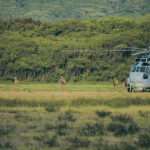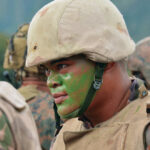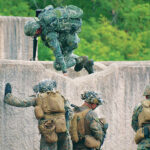RIMPAC participants practice coastal combat at Bellows



At this year’s Rim of the Pacific exercise, service members from countries in Asia, the Pacific islands and Latin America have joined American Marines in training around Bellows Beach, practicing amphibious fighting tactics.
On Saturday a combined force of U.S. Marines and troops from Peru, Tonga, Sri Lanka, the Philippines, Indonesia, Malaysia and Mexico assaulted one of several mock towns the U.S. military had originally built at its Bellows training area in Waimanalo to prepare Marines to fight in Iraq and Afghanistan.
ADVERTISING
A force of Peruvian marines dropped in by helicopter in a nearby field and scouted the area before a joint force of U.S. and Peruvian marines and Malaysian soldiers moved in with armored vehicles to secure it.
Then more helicopters arrived, dropping off soldiers and marines from around the world before they charged into the town to retake it from a simulated hostile force. Above, American warplanes swooped in to provide air support.
As they fought house to house with the sound of blank rounds echoing, senior military commanders from around the world and other invited dignitaries sat beneath a tent and watched as the international force gave them a demonstration after weeks of training.
Militaries across the world — especially in the Pacific — have in recent years given new attention to amphibious forces and operations.
After two decades of operations in Iraqi deserts and Afghan mountains, the U.S. Marine Corps is ambitiously restructuring its forces to return to its roots as a naval fighting force focused on coastal and island operations.
Tensions in the Western Pacific and China’s growing military might have played a major role in this shift.
The U.S. 15th Marine Expeditionary Unit planned much of the training at Bellows. Its members have been on a deployment aboard the amphibious transport ship USS Somerset, participating in exercises in the Pacific and Indian oceans — including with several of the countries participating in RIMPAC — and are wrapping up their voyage in Hawaii before returning to California.
Capt. Rob Howell, an officer with the unit, planned the assault on the town and coordinated air traffic overhead. It was a high-tech operation, with an MQ-9 drone silently watching the exercise from 27,000 feet providing real-time surveillance video to commanders as they moved their forces across Bellows.
But much of the technology wasn’t visible to those watching on the ground.
“Things like tablets, or radio networks, we had some satellite networks we were working with today,” Howell said. “So really leveraging digital and technological assets from across the combined force, leveraging some of our partnered assets as well, in support of our maneuver.”
RIMPAC has historically been an opportunity for military forces to try out new technology and tactics. At Bellows for the amphibious fighting forces, few are first-time participants this year. Howell said a lot of the technology they brought is also familiar.
“I’d say what may be new for this iteration of RIMPAC is the amount that we have been able to integrate in partnership with some of these technological assets,” he said. “So while there may have been persistent overhead (surveillance) in the past, or there may have been tablets on the deck, what really sets RIMPAC 2024 apart from some predecessors is just the integration with some of our partners, really that shoulder-to-shoulder integration, leveraging those assets from our partner nations rather than just unilaterally registering them from the American side.”
The forces participating in RIMPAC this year arrived in Hawaii as simmering tensions in the Pacific seemed to reach a boiling point.
Countries around the world have anxiously watched events in the South China Sea, a busy waterway that more than a third of all international trade travels through. Beijing has claimed it as its exclusive sovereign territory over the objection of neighboring countries.
In June, just before RIMPAC began, members of the Chinese coast guard rammed and boarded Philippine navy boats that were resupplying Philippine marines at BRP Sierra Madre, a rusted old ship the Philippine military intentionally grounded on the Second Thomas Shoal to serve as an outpost.
Rising tensions prompted the Philippines to scale back its planned RIMPAC participation, deciding not to send a ship in order to keep more forces ready to respond in disputed waters. But while international military forces trained at RIMPAC in Hawaii, diplomats worked to diffuse tensions in the Western Pacific.







